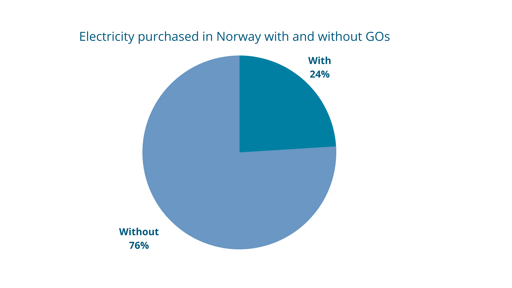How to achieve a greener power consumption?
Electricity in Norway in short
98% of electricity produced in Norway is renewable energy and most of it comes from hydropower. Many Norwegians might think there is no point in reducing their energy consumption because Norwegian electricity is renewable and has low to no emissions. But is it however that simple?
Are you familiar with Guarantees of Origin (GO)?
A Guarantee of Origin is a guarantee that specifies how and where the power is produced. It typically makes the choice between renewable and non-renewable power easier for the customer. The Guarantees of Origin give also an extra source of income to the power producers when they sell renewable electricity to power suppliers. This gives the power producers an incentive to increase the production of renewable energy.
The Guarantee of Origin is a scheme that aims to increase the demand for renewable energy and gives the consumers an opportunity to use their consumer power. However, only 24% of Norwegians bought Guarantees of Origin in 2020 (graph 1).

Graph 1: NVE statistics (2020)
The consequence of buying electricity without a GO
The guarantee prioritizes delivering electricity from renewable sources to someone who has purchased a guarantee. This applies even to consumers residing in countries outside Norway. For example, a consumer living in France, who would normally buy electricity from non-renewable sources, is given the opportunity to buy guarantees of origin from Norwegian hydropower.
The result is that a Norwegian consumer without a Guarantee of Origin, is not ensured to receive clean Norwegian electricity because it might have been already sold to another consumer with a GO. So even though 98% of all electricity in Norway is from renewable sources, a resident in Norway is not prioritised.
Only 11% of electricity purchases without a Guarantee of Origin come from renewable energy. The rest (89%) comes from fossil fuels (59%) or nuclear power (30%).
.png?width=512&name=Add%20a%20subheading%20(1).png)
Graph 2: NVE's product declaration for electricity (2020)
Does it make sense to buy Guarantees of Origin?
Yes, but reducing your total energy consumption has a greater impact and therefore should be prioritised. Being aware of your own energy consumption and not wasting electricity is a good starting point. In order to do so, you can for example turn off unused electrical equipment, charge your car when outside electricity peak hours, and turn off the light when leaving a room.
With this as a basis, the next step may be to purchase electricity with a GO to encourage power producers to increase electricity production from renewable sources. That is when you can say you have done your part for reducing emissions from electricity.
What is the European Attribute Mix (EAM)?
European electricity without a GO is considered to derive from the European Attribute Mix. This energy mix consists of the remaining power (power without GOs) from all European countries and its emissions are calculated each year. For 2020 it was 402 g CO2e/kWh.
The Norwegian electricity with a GO has documented low (nearly zero) emissions from renewable sources.
